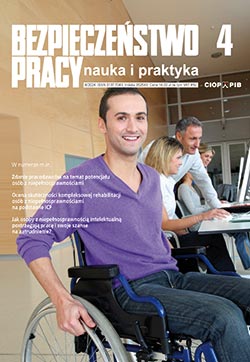Disturbances in the functioning of the endocrine system caused by nanomaterials
dr LIDIA ZAPÓR
The progress made in recent years in the field of nanotechnology has led to the development of many types of nanostructures whose impact on human health and the environment is still being studied. An area that is practically little recognized in scientific research is the effect of nanomaterials on the human endocrine system. The article presents the results of some studies indicating the potential effects of the engineering nanomaterials as substances that may interfere with homeostasis and the regulatory mechanisms of the endocrine system.
Combined exposure to chemical substances toxic to abilities to propagate – characteristics of the problem
dr KATARZYNA MIRANOWICZ-DZIERŻAWSKA
Substances toxic to ability to propagate (including those acting by disrupting the endocrine system) are classified in accordance with Regulation (EC) No 1272/2008 of the European Parliament and of the Council. Pursuant to this regulation, the rules on classification mixtures of such substances are also established, however, the assessment of the effects of combined exposure to substances from many different sources or spread through different routes remains are still a problem. This article discusses the problem of exposure to chemical substances mixtures, among which there is a possibility of mutual interaction, causing that mixtures may pose unexpectedly high hazards to human health.
Maximum permissible exposure (MPE) in the assessment eye and skin hazards caused by laser radiation
dr inż. GRZEGORZ OWCZAREK , dr inż. JOANNA SZKUDLAREK , dr inż. MARCIN JACHOWICZ
The article describes how to determine or calculate the value of the maximum permissible exposure (MPE) of laser radiation to eyes and skin. The importance of these values in the risk assessment of human exposure to accidental laser radiation were also discussed. The developed algorithms for determining MPE are based on the guidelines set out in the Regulation of the Minister of Labour and Social Policy of June 6, 2014 on the maximum permissible concentrations and intensities of harmful factors in the work environment. Examples of calculations carried out with the use of the developed algorithms are also presented. These examples show the importance of MPE in assessing the risk of human exposure to accidental exposure to laser radiation.
Evaluation of anti-vibration materials for protective footwear – original research results
mgr inż. MAŁGORZATA REJMAN , mgr inż. JACEK ZAJĄC , dr inż. PIOTR KOWALSKI
Anti-vibration materials have been successfully used for years in personal protective equipment to protect the human body against hand-arm vibrations. However, in the case of individual protections dedicated to reduce whole-body vibrations (transmitted through feet, pelvis, back or sides) the market offers practically no solutions. One of the ways to protect against whole-body vibration through feet can be footwear with anti-vibration properties. The use of anti-vibration materials in an insole or insock of such footwear can reduce the transmission of vibrations from a source to employee's body.
The article presents a method (developed in CIOP-PIB) assessing the transmission of mechanical vibrations through the construction elements of a sole (insole, insock) for use in footwear as individual protection against whole-body vibrations transmitted by feet. The results of tests of insole/insock models were also discussed.




























